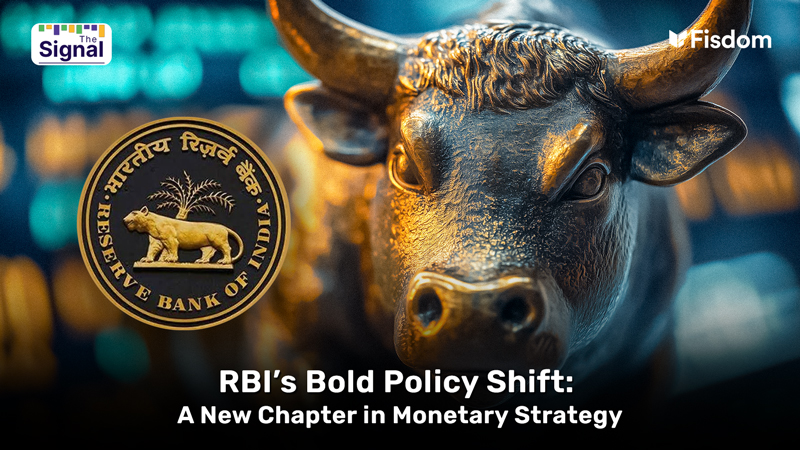
In a move that surprised markets and signaled a decisive recalibration of its monetary toolkit, the Reserve Bank of India (RBI) delivered one of its most aggressive policy actions in recent years. The central bank announced a 50 basis points (bps) cut in the repo rate—double the market expectation of 25 bps—paired with a significant 100 bps reduction in the Cash Reserve Ratio (CRR). This double-barrelled easing underscores the RBI’s commitment to strengthening monetary transmission and supporting economic momentum amid evolving macroeconomic conditions.
Importantly, the central bank also changed its policy stance from “accommodative” to “neutral,” indicating a strategic pause after frontloading monetary support. The shift reflects RBI’s intention to wait and assess the impact of the measures, rather than committing to an extended easing cycle.
Parsing the Rate Cut and CRR Move
The 50 bps rate cut—unusual outside crisis periods—signals a proactive, rather than reactive, approach. The RBI appears to be looking ahead, recognizing the lagged effect of monetary policy and choosing to inject support well in advance of any visible slowdown. While inflation remains well within the RBI’s target range, this preemptive move suggests confidence in price stability and a desire to push for stronger growth momentum.
Even more noteworthy is the CRR cut, which is rarely used outside exceptional circumstances. The reduction from 4% to 3% (effective September) releases substantial liquidity into the banking system, estimated to be over ₹9.5 trillion over six months. What’s striking is that this measure comes despite the current surplus liquidity environment, indicating that the central bank is focused on removing structural bottlenecks in transmission rather than just reacting to headline liquidity levels.
The CRR adjustment, along with the shift to a neutral stance, sends a clear signal to financial markets: while the RBI has delivered aggressive easing, it does not intend to fuel speculative expectations of continued rate cuts. Instead, the emphasis is on ensuring liquidity flows through the system effectively, rather than relying solely on incremental rate actions.
Inflation Cooling, Growth Recovery in Sight
The RBI’s policy changes are underpinned by a favourable inflation outlook. With core inflation remaining muted and food prices showing stability, the central bank has revised its inflation forecast for FY26 down to 3.7% from 4%. This reinforces the narrative that inflation risks are well contained, giving the RBI room to focus on growth revival.
On the growth front, while the central bank remains cautiously optimistic, it acknowledges the risks from global trade disruptions and geopolitical uncertainties. Domestic consumption is expected to benefit from a normal monsoon, and investment activity continues to be buoyed by government capital expenditure. The FY26 GDP growth estimate has been maintained at 6.5%, reflecting confidence in the economy’s underlying resilience.
Implications for Liquidity and Interest Rates
The RBI’s liquidity stance is particularly crucial in the current environment. While policy rates may not fall further in the near term, the central bank appears committed to maintaining an accommodative liquidity environment for an extended period. This is especially pertinent given the RBI’s large forward FX liabilities (estimated at over $50 billion), which could gradually draw liquidity out of the system through USD purchases.
By announcing the CRR cut in advance, the RBI ensures that liquidity stays abundant even as FX operations evolve. This assurance of long-term surplus liquidity is likely to nudge banks toward deploying funds more actively, particularly in the short-to-medium end of the yield curve.
The excess liquidity is already having visible effects—Certificate of Deposit (CD) issuances by banks have slowed, credit growth remains tepid, and inter-bank rates are anchored. Over the next few months, deposit rates are likely to soften further, adding downward pressure on short-term yields.
Fixed Income Strategy: Focus on Quality and Tenor
For investors, this evolving backdrop necessitates a strategic reassessment. With much of the easing cycle already delivered and future rate cuts less likely, the yield curve is expected to flatten at the shorter end. Consequently, the 1–3-year segment of the curve presents a sweet spot—offering both visibility and stability.
Funds in the short duration, banking & PSU, and corporate bond categories appear well-positioned to benefit from the twin forces of surplus liquidity and a lower cost of funds. These strategies offer reasonable accrual income with the added potential for mark-to-market gains as spreads compress.
For duration investors, the scope for further capital appreciation is more limited, although some residual upside may still exist. A barbell strategy—combining a modest allocation to longer-duration assets with core exposure to high-quality short- to medium-term accrual funds—can help manage reinvestment risk while retaining some upside potential.
Conclusion: A Measured Yet Bold Pivot
The RBI’s latest policy action marks a significant turning point in its monetary strategy. By delivering an aggressive easing move while simultaneously tempering forward guidance through a neutral stance, the central bank has balanced the need for support with the risks of over-extension.
For investors, the key takeaway is clear: prepare for a “lower for longer” rate environment, where liquidity stays ample but rates remain range-bound. In such a scenario, thoughtful positioning across high-quality accrual strategies and a focus on the 1–4-year segment of the curve can help optimize risk-adjusted returns.
As transmission strengthens and policy takes effect, the landscape for fixed income investing is set to become more about strategic calibration than chasing yield. The RBI has fired its shots—and now, it’s the market’s move.
Market this week
| 02nd June 2025 (Open) | 06th June 2025 (Close) | %Change | |
| Nifty 50 | ₹ 24,670 | ₹ 25,003 | 1.4% |
| Sensex | ₹ 81,214 | ₹ 82,189 | 1.2% |
Source: BSE and NSE
- Indian benchmark indices rose 1% during the week, snapping a two-week losing streak, driven by the RBI’s twin policy support—50 bps repo rate cut and 100 bps CRR cut.
- Sectorally, Nifty Realty outperformed with a sharp 9.5% weekly gain, followed by Nifty Metal (+2.3%), Nifty PSU Bank (+2%), and Nifty Auto (+1.4%).
- Foreign Institutional Investors (FIIs) remained net sellers for the third straight week, offloading equities worth ₹3,565.88 crore.
- Domestic Institutional Investors (DIIs) sustained their buying momentum for the seventh week in a row, investing ₹25,513.43 crore in Indian equities.
Weekly Leaderboard
| NSE Top Gainers | NSE Top Losers | ||||
| Stock | Change (%) | Stock | Change (%) | ||
| Eternal | ▲ | 9.9% | HDFC Life Insurance | ▼ | -2.8% |
| Shriram Finance | ▲ | 7.7% | TCS | ▼ | -2.3% |
| Dr. Reddy’s Labs | ▲ | 5.6% | TATA Steel | ▼ | -2.2% |
| M&M | ▲ | 4.4% | SBI Life | ▼ | -1.7% |
| Adani Ports & SEZ | ▲ | 2.7% | Bajaj Finserv | ▼ | -1.4% |
Source: BSE
Stocks that made the news this week:
Cochin Shipyard Rallies on Defence Optimism:
Cochin Shipyard surged over 8% intraday on Friday, marking its fourth consecutive session of gains, driven by heightened optimism around rising defence spending. Investor sentiment was lifted after Defence Secretary Rajesh Kumar Singh indicated India could raise defence expenditure to 2.5% of GDP by FY30 from the current 1.9%, highlighting improved budget utilisation and faster contract finalisations.
Metal Stocks Gain on RBI Rate Cut Boost:
Metal stocks rallied sharply on June 6 following the RBI’s surprise 50 bps repo rate cut, surpassing market expectations. The Nifty Metal index climbed 1.4%, led by gains in JSW Steel (+4%), Jindal Stainless (+3%), and Hindustan Zinc (+2%). The rally mirrored strength across other rate-sensitive sectors like banking and realty, with benchmark indices also surging—Sensex up nearly 800 points and Nifty crossing the 25,000 mark.
Tata Investment Corp Jumps on IPO Buzz:
Tata Investment Corporation surged 8% to ₹7,150 after reports indicated that SEBI may soon approve Tata Capital’s ₹17,200 crore IPO. The stock gained on expectations that the IPO will unlock significant value for shareholders and further strengthen Tata Group’s footprint in the financial services space
.














